Growing delicious and beautiful eggplant in your home garden is easier than you may think. In this post, I’ll show you all you need to know in order to have your best crop ever.
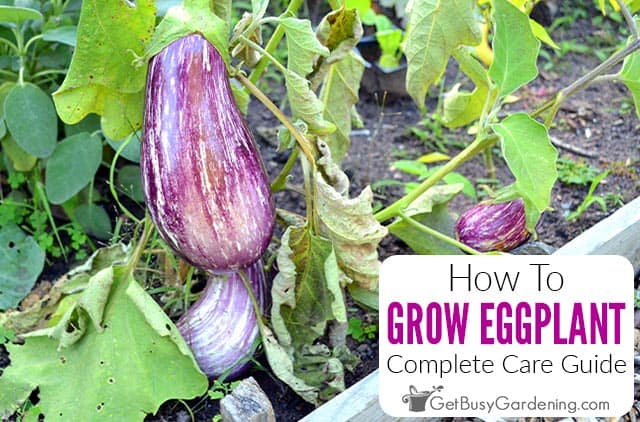
Even the newest beginner can grow eggplant successfully by learning how to provide the right environment and care to keep them thriving.
In this complete guide, I’ve shared all of the information you need to successfully grow eggplant.
Including sun, water, fertilizer, and what soil they need, plus how to deal with pests, diseases, and so much more.
Quick Eggplant Care Overview
| Scientific name: | Solanum melongena |
| Classification: | Vegetable |
| Common names: | Eggplant, Aubergines |
| Hardiness: | Zones 10+ |
| Temperature: | 70-85°F |
| Flowers: | Light purple, blooms spring-summer |
| Light: | Full sun |
| Water: | Keep evenly moist, do not overwater |
| Humidity: | Average |
| Fertilizer: | High phosphorus fertilizer spring-summer |
| Soil: | Rich, fertile, well-draining |
| Common pests: | Potato beetles, hornworms, whiteflies |
Information About Eggplant
Eggplant (Solanum melongena) is a member of the Solanaceae, or nightshade, family, which also includes tomatoes, potatoes, tomatillos, and peppers. In some parts of the world they’re known as aubergines.
They’re native to India and Asia, but are now cultivated all over the world for their delicious, spongy, edible fruit. They’re tender perennials in tropical climates, but most are grown as annuals.
The tall, flowering, bush type plants can reach 4’ in height, and develop fruits that range in color, size, and flavor.
Different Types Of Eggplant
There are many, many eggplant varieties out there to try. They can be the familiar large pear shape, long and skinny, short and round, or even ridged.
The color of the fruits can range too. There are green, white, various shades of purple, and variegated ones that feature white striping. Depending on the type, the flavor may be sweet to somewhat bitter.
There’s no wrong or right variety to choose, so select them based on how you like to cook them, and what will perform best in your growing zone.
Check out popular varieties like Black Beauty, Galine, Early Midnight, White Star Hybrid, Rosa Bianca, Green Knight, or Long Purple to get started.
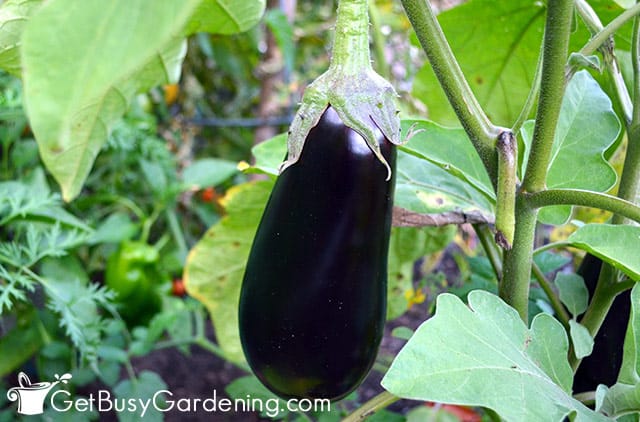
Hardiness
Eggplants grow well as annuals in any climate, and are perennials in only the warmest zone of 10-12.
They’re a hot weather plant that thrives in warm environments with plenty of sun, and will suffer when temperatures drop below 50°F.
How Do Eggplants Grow?
The edible eggplants grow from self-pollinating, purple flowers that sprout from the leafy stems.
Bees, butterflies, wind, or even your finger brushing around the flowers is enough to pollinate them.
Once fertilized, the flowers will begin to grow baby fruits that swell in size and deepen in color as they mature.

How To Grow Eggplant
Before we get into how to care for them, first we should discuss the best time and location to grow eggplant. Choosing the right spot can make a big difference in your overall success.
Where To Grow Eggplant
Eggplants grow best in fertile soil with plenty of sun, and warm temperatures. They can perform equally well in garden beds or containers.
When choosing a pot, make sure it’s large enough to support the root system, and that it has drainage holes on the bottom. Aim for a 12” size or larger.
The plants will also need a support system to help them stay upright as the heavy fruits set. Place stakes or a wire cage when planting.
When To Plant Eggplant
Eggplants need heat and sun to grow their best, so it’s not beneficial to plant them outside early.
Wait until all chance of frost has passed, nighttime temperatures are consistently above 50°F, and the ground has warmed up to avoid stunting their growth.
Aim for a temperature of at least 65°F on your soil thermometer before planting it.

Eggplant Care & Growing Instructions
Now that you know when and where to grow eggplant, let’s talk in detail about how to give them the proper care. It’s important to create an ideal environment in order to have highly productive plants.
Sunlight
Eggplant needs full sun to grow, ideally between 6-8 hours of direct light every day. They won’t produce as well, or at all, in the shade.
If you don’t have a sunny garden plot, then it’s best to keep them in containers so you can place them in an area where they will enjoy full exposure.
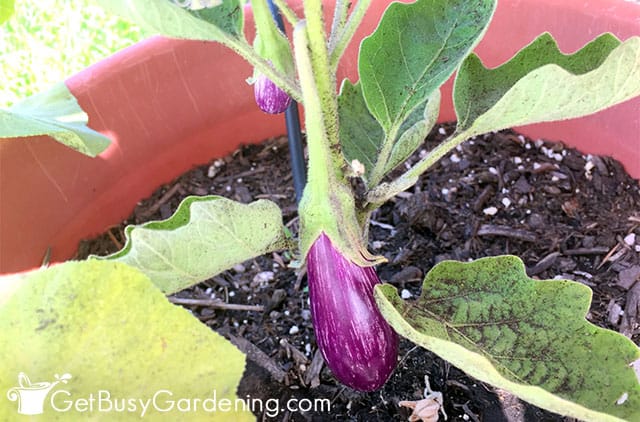
Water
Consistent, even watering is key to healthy fruit development, but they do not like soggy feet.
Give them a drink when the soil is dry 1-2” down, and check frequently to make sure they stay evenly moist.
Don’t puddle it with excess water however, as that can lead to rot. A moisture gauge can help you get it just right.
In hot weather, they’ll need more frequent drinks, so check them often during heat waves. Mulching can also help them retain moisture.
Temperature
The ideal temperature range for eggplant is 70-85°F. They can set flowers and fruit down to 60°F, but they will mature much slower in cooler temps.
Anything below 50°F will lead to blossom and fruit drop, and cause damage to the plant.
When temps sore above 95°F, it can also affect fruiting. Use a shade cloth in the afternoon during heat waves to protect them and help mediate that.
Fertilizer
Routine feedings is an important part of eggplant care, and will help lead to highly productive, thriving plants.
Every two weeks you can apply an organic water soluble option like fish emulsion or compost tea. Then add slow release-granules once a month as well.
Avoid fertilizers that are high in nitrogen, or you may end up with too much foliage and no flowers.

Soil
Eggplants grow best in well-drained, fertile soil with a pH ranging from 5.5 to 7.0. Use an inexpensive probe to test it.
Amend your beds with compost to add more organic material and help with drainage, and use garden lime to neutralize acidity, if necessary.
Pruning
Pruning can help create a leafy canopy early on that protects the developing eggplants from sunburn. Use precision shears to trim away any suckers and the first set of flowers.
As the summer continues, remove diseases or damaged leaves, especially near the base, to improve airflow for any developing fruit.
At the end of the season, you can top the plant and remove all of the flowers to force it to focus on ripening any remaining fruit before the cold sets in.
Pest Control Tips
There are a variety of pests that can affect growing eggplant, such as flea beetles, potato beetles, hornworms, army worms, and whiteflies.
Handpicking large bugs and trimming away heavily infested foliage or leaves with eggs can slow down them down.
Applying organic control options like diatomaceous earth, neem oil, or insecticidal soap can also help. I make my own by combining 1 teaspoon of mild liquid soap with 1 liter of water.
You can also try row covers early in the spring and summer, and mulching to keep bugs at bay.
Disease Control Tips
Fungal and bacterial diseases like blight, verticillium wilt, anthracnose, and powdery mildew can also be a problem.
The best methods for preventing disease are using mulch, and watering near the base of the plant instead of overhead. This will prevent splashing water and soil on the foliage.
If you see any signs of disease, like yellow, brown, or white spots, trim away infected foliage, and try treating it with an organic fungicide.
If it continues to spread, pull and destroy the plant to make sure it doesn’t affect the rest of your garden.
Tips For Harvesting Eggplant
Eggplant is best picked when it’s young and tender, which also encourages it to grow more fruit.
The particular size, shape, and color of mature fruit will vary by variety, so check the plant tag or seed packet to learn about your particular type.
When you’re ready to harvest, use a sharp pair of pruners to snip the fruit, making your cut 1-2” up on the stem. Avoid pulling or tugging it off, which can damage the delicate stems and the plant.
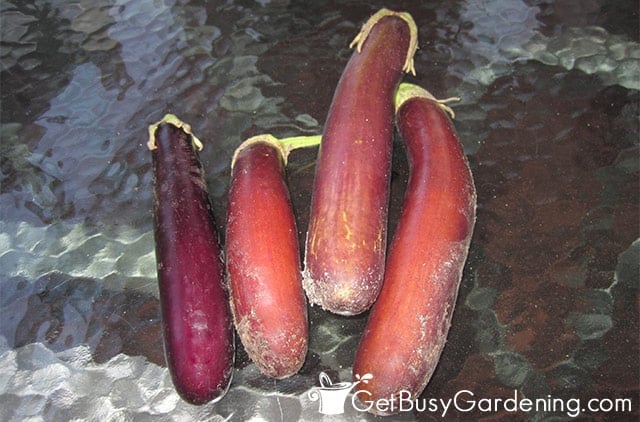
Troubleshooting Common Problems
While learning how to grow eggplant, you may face one of these common issues. Use the tips below to troubleshoot and get your plant back into good health.
Eggplant Leaves Curling
If the leaves are starting to curl under themselves, it’s a sign of pests, disease, or inconsistent watering.
Make sure they’re receiving even moisture. They should not dry out more than an inch or two down, or sit in soggy, wet soil.
If the leaves are also riddled with holes or spots, you may be dealing with bugs or wilt disease. Trim away affected foliage, and inspect closely for bugs.
Bottoms Of Fruits Rotting / Blossom End Rot
If the ends of the fruits are rotting while still on the vine, you’re dealing with blossom end rot, which is caused by a lack of calcium uptake. This can be a result of over fertilizing, or inconsistent watering.
Avoid letting the eggplant go between very dry periods to very wet periods. Instead aim for consistent, even moisture.
Also avoid using nitrogen-heavy fertilizers, and add calcium supplements like eggshells or bone meal if needed. Affected fruit cannot be saved, unfortunately.
Yellow Leaves
Yellowing leaves is usually a sign of pest infestation, overwatering, or a nutrient deficiency. Inspect them closely, and apply an insecticidal spray to target bugs if necessary.
Applying an organic fertilizer throughout the season is the best way to combat a nutrient deficiency.
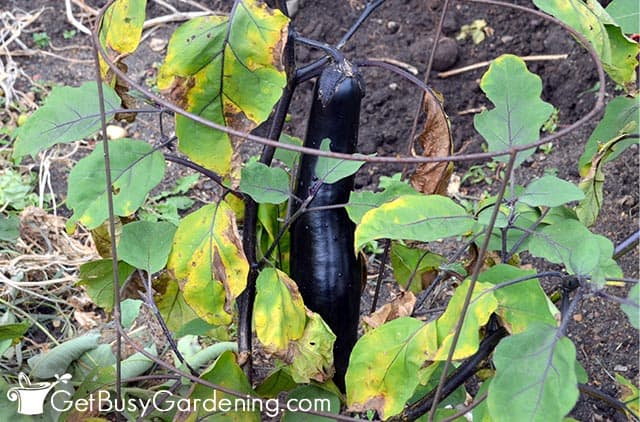
FAQs About Growing Eggplant
Here I’ve answered some of the most commonly asked questions about growing eggplant. If yours isn’t on the list, please add it to the comments section below.
Is eggplant easy to grow?
Eggplant can be easy to grow once you understand how to give it the care it needs. Plenty of sun, fertile soil, consistent moisture, and warm temperatures are all key factors to a happy plant.
How long does it take for eggplants to grow?
How long it takes for eggplants to grow will vary depending on the particular variety you have. The maturity dates can range widely, but it’s typically between 85-120 days from seed to harvest.
How many eggplants do you get from one plant?
It’s hard to give a set number on how many eggplants you’ll get from one plant, because it can be affected by the growing environment, climate, and variety. They’ll continue to produce so long as they get plenty of water, sun, and temperatures between 60-85°F.
How long do eggplant plants live?
Eggplant plants can live up to three years in very warm climates, like zones 10-12. But in most regions they’re grown as annuals, and only live for one season.
Do eggplants need a lot of sun?
Yes, eggplants need a lot of sun. They are a heat loving plant that will thrive and produce best when given 6-8 hours of direct exposure each day.
What month do you plant eggplant?
The right month to plant eggplant will depend on your region’s climate. Wait until all chance of frost has passed and temperatures are consistently above 60°F.
Now that you understand what eggplants need to thrive, you can be successful growing any variety in your home garden. Use these care tips to encourage healthy, productive plants all season long.
If you’d like to learn how to make the most of your space and get as much homegrown food as possible, then my Vertical Vegetables book is perfect! It will teach you all you need to know, has tons of gorgeous inspirational photos, and 23 DIY projects you can build for your own garden. Order your copy today!
Learn more about my Vertical Vegetables book here.
More About Vegetable Gardening
- How To Grow Green Beans
- How To Grow Onions
- How To Grow Winter Squash
- How To Grow Okra
- How To Grow Passion Fruit
- How To Grow Cauliflower
Share your tips for how to grow eggplant in the comments section below.

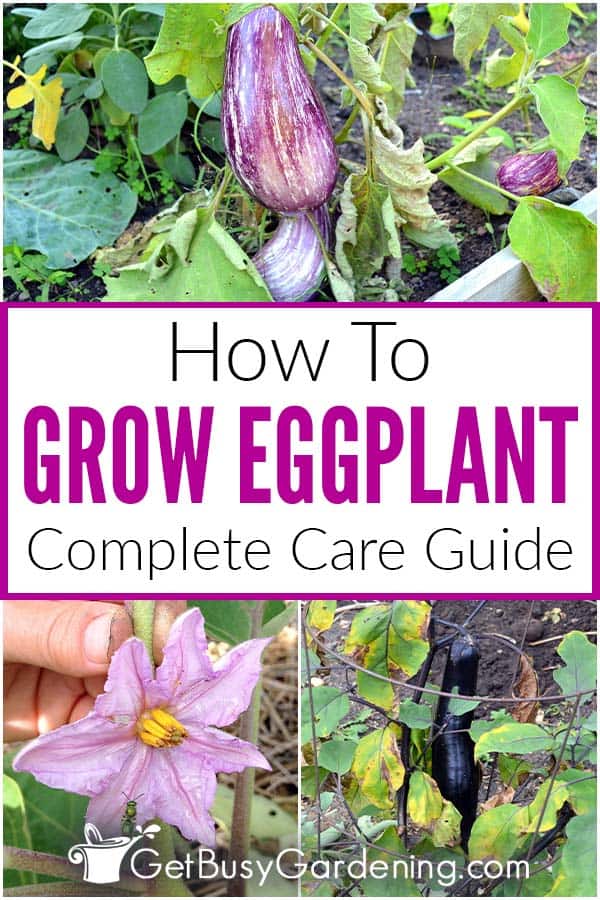
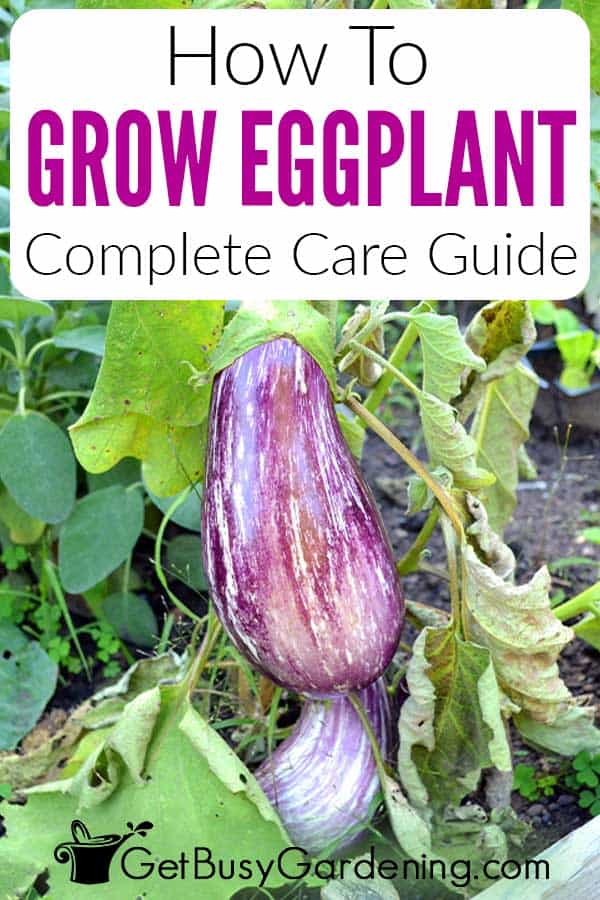



Leave a Reply